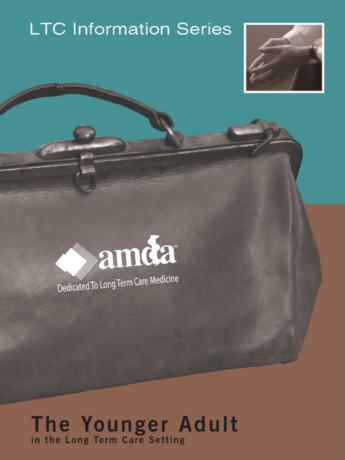Long-term care (LTC) is no longer synonymous with "geriatric care." In the past 10 years, adults ages 31 to 64 have been the fastest growing population in nursing homes. The last national nursing home survey sponsored by the Centers for Disease Control and Prevention (CDC) in 2008 estimated that nearly 12% of nursing home residents are aged less than 65 years.
In this manual, younger adults are defined as those as those aged 18 to 64 years. Younger adults are differentiated from their older counterparts in more ways than merely age, and this poses unique challenges and opportunities. For example, the clinical syndromes afflicting the various groups differ. Compared with older residents, younger adults in LTC have
- More diagnoses related to mental retardation and developmental disabilities
- A higher prevalence of hemiplegia and quadriplegia, especially related to trauma
- Suffer an increased prevalence of chronic and neurological disorders, such as Huntington's disease (HD), muscular dystrophy (MS), Amyotrophic lateral sclerosis (ALS), cerebrovascular accident, Alzheimer's disease, Parkinson's disease, peripheral vascular disease, and cardiac diseases
- Psychiatric diagnoses are significantly higher
- More likely to have residential histories of prior stays in psychiatric facilities
In general, the younger residents of LTC fall into three general groups on the basis of the etiology of their illnesses and disabilities, which require different approaches by LTC staff. The main categories of younger adults are those with
- Illnesses from capricious fate, including chronic, progressive, psychiatric, or neurologic illnesses such as MS, HD, ALS, or schizophrenia that they have been coping with for years;
- Illness and possibly institutionalization from birth or childhood; or
- A sudden onset of physical problems related to injury (such as a traumatic brain injury), misfortune, or lifestyle choices.
AMDA's The Younger Adult in the Long-Term Care Setting manual addresses questions that must be considered by LTC organizations in the care of younger adults include the following:
- What are the care needs and goals of care for these patients?
- How will these residents' psychological, social, psychiatric, sexual, and other basic human needs be met?
- How do facilities assist younger residents in coping with the possibility of spending 30, 40, or even 50 years or more of their life in a nursing home?
- What activities does the facility offer specifically for younger adults?
The manual is designed for use by all professionals of the interdisciplinary team, including practitioners and medical directors, social workers, nurse clinicians and administrators, psychologists, and recreational and rehabilitation professionals, and aims to be practical rather than theoretical. It also addresses problem-solving methodology that can be applied to other populations and concerns within the LTC field. Specifically, the goals of this manual are:
- To expand our view about what a LTC patient "looks like"
- To provide a resource for managing difficult cases in LTC settings along with care planning tips and effective interventions
- To identify best practices and specific tools used by facilities with a higher proportion of younger residents that can be adapted to other settings
Prices

The Electronic Copy is in FlipHTML5 format, and is viewable from your PC, tablet and smartphone through your PALTmed account. The Electronic Copy is not downloadable or printable.
